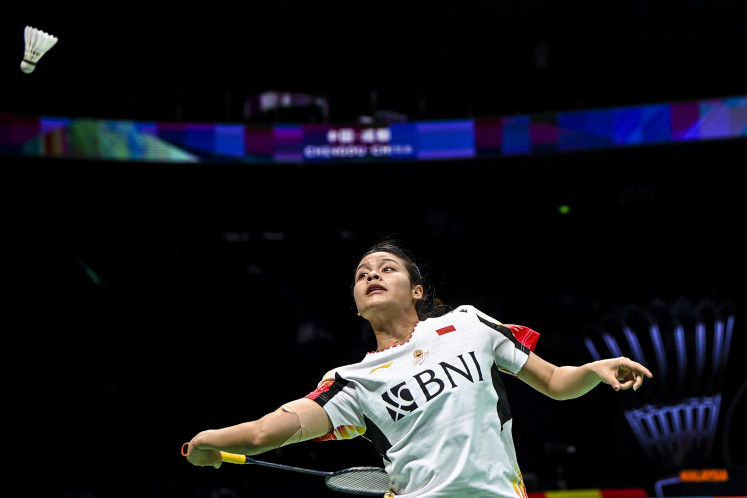Old-world KL with a Chinese twist
Kuala Lumpurâs Chinatown
Change Size
 Kuala Lumpurâs Chinatown. (JP/Tan Hee Hui)" border="0" height="383" width="510">Kuala Lumpurâs Chinatown. (JP/Tan Hee Hui)
Kuala Lumpurâs Chinatown. (JP/Tan Hee Hui)" border="0" height="383" width="510">Kuala Lumpurâs Chinatown. (JP/Tan Hee Hui)Historical and colorful ethnic neighborhoods like Chinatown reflect Kuala Lumpurâs âbright lights, big cityâ image.
Buzzing with locals and foreign travelers checking out historic attractions, diverse places of worship, roadside stalls selling counterfeit goods and tucking into affordable yet delicious food.
Chinatown harks back to the halcyon days when evergreen numbers such as âMambo Rockâ and âLoverâs Tearsâ were heard over Rediffusion radios and the men wore traditional Pagoda tees.
Start your walking tour at Jl. Sultan, which begins at Foch Avenue or Jl. Tan Cheng Lock (as it is now known), where the Kota Raya complex is located.
The elderly Chinese folk who lived and conducted their businesses here (and still do) referred to Foch Avenue as âChee Tin Kaiâ â an endearing nickname for the vendors who sold things like bags, hair pins, combs, nail clippers and school uniforms at âskyrocketâ prices that are now more commonly found on designer labels.
 Food hawkers. (Courtesy of John Hung)
Food hawkers. (Courtesy of John Hung)
Customers were fond of bargaining with the traders, sometimes negotiating down to half the price. The mentality was: If thereâs no price slash, donât want.
âChee Tin Kaiâ is actually a term for a row of dilapidated, single-story zinc-roofed stalls that were situated on the site where the Kota Raya complex now stands. Oh, the wonderful malleability of Chinese dialects.
With the passing of time, drastic changes have come to pass on Jl. Sultan. The once-popular Tong Ah wine shop â where your grandfather would probably have bought his bottles of wine â has closed down.
Outside the Guardian pharmacy shop-lot, the space between the pedestrian walk at the side of the junction spilling out to part of the main road was where the Sultan Street railway station once stood.
The train route began from the still-standing Ampang station, heading to the now-defunct Pudu station before finally reaching Sultan Street.
For some theological trivia, visit the historic Methodist church located next to the Methodist Boysâ School, reputedly one of KLâs top three English boysâ schools.
Only the brightest young lads were allowed a place at the school, which was long-served by a Japanese headmaster â T. Mori. The Confucius Chinese School, a top Chinese boysâ school in KL, was right next door.
The headquarters of famous guilds and associations are galore on Jl. Sultan as well.
They include the Printers Association, Metal & Iron Association, the Selangor & Wilayah Persekutuan Grocerâs Association and the famous Selangor Keng Chui Association, whose members comprise the Hainanese community only.
Kuala Lumpur's Chinatown. (JP/Tan Hee Hui) Historical and colorful ethnic neighborhoods like Chinatown reflect Kuala Lumpur's 'bright lights, big city' image.
Buzzing with locals and foreign travelers checking out historic attractions, diverse places of worship, roadside stalls selling counterfeit goods and tucking into affordable yet delicious food.
Chinatown harks back to the halcyon days when evergreen numbers such as 'Mambo Rock' and 'Lover's Tears' were heard over Rediffusion radios and the men wore traditional Pagoda tees.
Start your walking tour at Jl. Sultan, which begins at Foch Avenue or Jl. Tan Cheng Lock (as it is now known), where the Kota Raya complex is located.
The elderly Chinese folk who lived and conducted their businesses here (and still do) referred to Foch Avenue as 'Chee Tin Kai' ' an endearing nickname for the vendors who sold things like bags, hair pins, combs, nail clippers and school uniforms at 'skyrocket' prices that are now more commonly found on designer labels. 
Customers were fond of bargaining with the traders, sometimes negotiating down to half the price. The mentality was: If there's no price slash, don't want.
'Chee Tin Kai' is actually a term for a row of dilapidated, single-story zinc-roofed stalls that were situated on the site where the Kota Raya complex now stands. Oh, the wonderful malleability of Chinese dialects.
With the passing of time, drastic changes have come to pass on Jl. Sultan. The once-popular Tong Ah wine shop ' where your grandfather would probably have bought his bottles of wine ' has closed down.
Outside the Guardian pharmacy shop-lot, the space between the pedestrian walk at the side of the junction spilling out to part of the main road was where the Sultan Street railway station once stood.
The train route began from the still-standing Ampang station, heading to the now-defunct Pudu station before finally reaching Sultan Street.
For some theological trivia, visit the historic Methodist church located next to the Methodist Boys' School, reputedly one of KL's top three English boys' schools.
Only the brightest young lads were allowed a place at the school, which was long-served by a Japanese headmaster ' T. Mori. The Confucius Chinese School, a top Chinese boys' school in KL, was right next door.
The headquarters of famous guilds and associations are galore on Jl. Sultan as well.
They include the Printers Association, Metal & Iron Association, the Selangor & Wilayah Persekutuan Grocer's Association and the famous Selangor Keng Chui Association, whose members comprise the Hainanese community only. 
The Keng Chui was the founder of the world-renowned Thean Hou Chinese Temple in KL.
It also used to manage the two-story Nam Kiow Chinese School, before it moved to another part of the city.
The Jl. Sultan premises have been converted into a multistory hotel, also managed by the same association.
The adjoining Jl. Hang Lekir ' previously known as Cecil Street or 'Si Si Kai' (as the Chinese-speaking city dwellers affectionately call it) ' has several food stalls serving sumptuous, low-priced food, such as the popular Hokkien and wantan noodle dishes.
Behind the Selangor Complex are two famous squatter food shops ' Siong Ying Chai and Sang Kee, helmed by a new generation after their forefathers' retirements.
The Siong Ying Chai is reputed for Chinese buns (pau), dim sum (dumplings) and cooked-to-order Chinese dishes, while the more-than-40-year-old Sang Kee specializes in similarly cooked-to-order dishes.
Occupying a shop-house built in 1917, the Old China Café (Jl. Balai Polis) serves Peranakan cuisine, which combines Malay, Chinese and Eurasian cooking styles.
Popular Chinese songs from the 1920s are featured to complement the period-inspired dining experience here.
We recommend the nyonya pai tee ' deep-fried wheat flour served with condiments such as bean sprouts, shredded turnip, carrots and dried shrimp. It comes with a side of chili for a stronger flavor. 
The local delicacy jui hu char (stir-fried shredded turnips, carrots, cuttlefish, mushrooms and chicken served with fresh lettuce and a side of chili) is in demand, too.
The Rex cinema, with a classic old-world façade designed by renowned local architect Datuk Kington Loo, is a landmark here.
Once a plush cinema where many evergreen films were shown, including Rebel Without a Cause starring James Dean in the 1950s, advanced bookings for tickets were not allowed.
Cinema-goers rushed and scrambled for tickets when popular films hit the cinema.
Recently, the visually arresting edifice was converted into a budget hostel.
If you fancy a haircut or shave, head to the barber's corner managed by Chan Hong, who has been plying his trade here for over 40 years.
Having learned his skills from his father, Chan Hong, 69, is a major hit among tourists. Little wonder, then, that he charges RM5 for a photo op.
Visitors can also check out his 'family heirloom' ' a 90-year-old plaque penned by his father and two 70-year-old barber chairs cemented to the ground. He also uses mainly antique tools for his trade.
Cheras is another part of KL with a large local Chinese population.
Driving around this morass of an ill-planned suburb, with many elusive addresses sprawled all over, will surely make you swear expletives behind the wheel.
For a less stressful journey, make your way to Taman Midah on the 8-9 kilometer (km) stretch and Taman Taynton, both located next to a highway.
These parts are dotted with night pubs, karaoke joints, kopitiam, hardware and sundry stores.
On the 5.3 km stretch along Jl. Cheras, the Jin Woh shop has been manufacturing Chinese sausages in the old method for over 35 years. Trays of sausages stacked up on one another can be seen inside the shop, which exudes an old-world charm, though it's not so appealing for vegetarians.
Also a gastronomic hub, Cheras has many eateries that offer traditional, affordable as well as upscale fare.
Restoran Choong Huat (22-23, Block P/E, Taman Cheras), for instance, is often packed with customers enjoying a wide variety of affordable soups.
Choose from chicken, tom yam, herbal soups or seaweed soup with wine, black pepper, coriander or century egg soups.
The outlet's Seafood Farci (5 ringgit), oyster omelet (9 ringgit), grilled chicken wings and a steaming hotpot filled with fresh ingredients like seafood are also must-tries.
Not many people know how to define the position of Pudu Ulu, a short drive away from Cheras.
No doubt it is located in the Pudu area, but it actually lies at the foot of the fourth mile hill on Cheras Road (and is 1.2 km from KL's city center).
Pedestrians used to find it difficult to maneuver the gradient that winds its way up and around the hill.
There were some 60 houses on both sides of the highway, excluding the numerous Chinese outlying huts and kongsi houses.
The local Chinese here used to earn their livings from the nearby mines, either directly or through supplying the miners. The mine pools have since been filled up and Pudu Ulu has experienced drastic changes.
For traditional Hakka Chinese dishes prepared in various ways, including in a clay pot or on an aluminum platter, the Yap Chong Restaurant, a short distance from AEON Maluri supermarket), is the restaurant called It.
Highlights at this 47-year-old establishment include the stewed pork belly and yam and the sweetish mui choy chu yoke (pork with preserved vegetables in a clay pot), which have a wonderful mixture of flavors. Bon appetit!
Your Opinion Matters
Share your experiences, suggestions, and any issues you've encountered on The Jakarta Post. We're here to listen.
Thank You
Thank you for sharing your thoughts. We appreciate your feedback.









